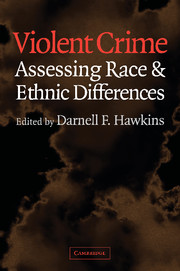Book contents
- Frontmatter
- Contents
- Contributors
- Foreword
- Editor's Introduction
- Violent Crime
- Part I Homicide Studies
- Part II Other Contexts, Settings, and Forms of Violence
- 6 Sanction Effects, Violence, and Native North American Street Youth
- 7 Ethnicity and Interpersonal Violence in a New Zealand Birth Cohort
- 8 Racist Victimization in England and Wales
- 9 Race, Gender, and Woman Battering
- 10 Gender Entrapment and African-American Women: An Analysis of Race, Ethnicity, Gender, and Intimate Violence
- Part III Explaining Racial and Ethnic Differences
- References
- Index
6 - Sanction Effects, Violence, and Native North American Street Youth
Published online by Cambridge University Press: 22 August 2009
- Frontmatter
- Contents
- Contributors
- Foreword
- Editor's Introduction
- Violent Crime
- Part I Homicide Studies
- Part II Other Contexts, Settings, and Forms of Violence
- 6 Sanction Effects, Violence, and Native North American Street Youth
- 7 Ethnicity and Interpersonal Violence in a New Zealand Birth Cohort
- 8 Racist Victimization in England and Wales
- 9 Race, Gender, and Woman Battering
- 10 Gender Entrapment and African-American Women: An Analysis of Race, Ethnicity, Gender, and Intimate Violence
- Part III Explaining Racial and Ethnic Differences
- References
- Index
Summary
In the last three decades, researchers of the relationship between race and crime in North America have broadened their focus beyond differences between blacks and whites to include other groups: for example, studies of Hispanics and Asians are increasingly common. However, one group is continually underrepresented in studies of crime and, particularly, studies of violence: American Indians, or, as they are known in Canada, Aboriginals. In the preamble to her groundbreaking study of violence among American Indians, Bachman (1992) notes that prior to her work, multivariate studies of causes of Aboriginal violence were virtually nonexistent. Four years later, Nielsen and Silverman (1996: xii) found little had changed since Bachman's research. They remark that,
[i]n putting together this volume, we discovered that empirical research on Native peoples was relatively scarce in the crime and criminal justice literature…. In fact it is reasonable to say that Native issues of crime and justice have been neglected in U.S. research.
This oversight is surprising. Although Native peoples represent a small proportion of American and Canadian populations, they are consistently overrepresented in these nations' arrest and incarceration statistics. For example, Silverman (1996) estimates that in the period between 1987 and 1992, less than 1 percent of the U.S. population was American Indian; however, in these years the arrest rate for violent crime among American Indians was approximately 50 percent higher than for white Americans; for homicide, it was about 70 percent larger (see also Bachman, 1992; LaFree, 1995; Snyder-Joy, 1995).
- Type
- Chapter
- Information
- Violent CrimeAssessing Race and Ethnic Differences, pp. 117 - 137Publisher: Cambridge University PressPrint publication year: 2003

